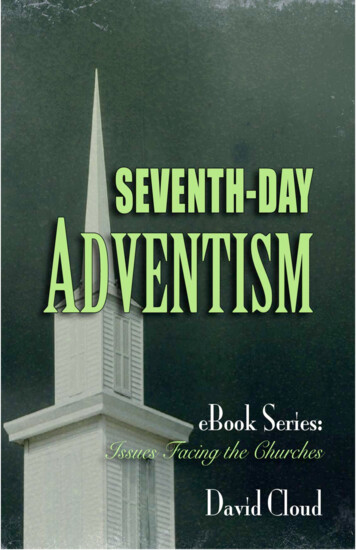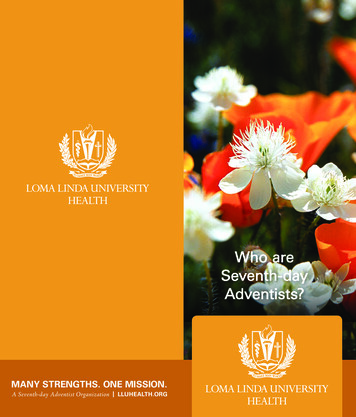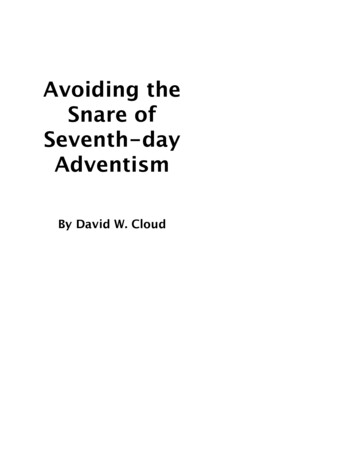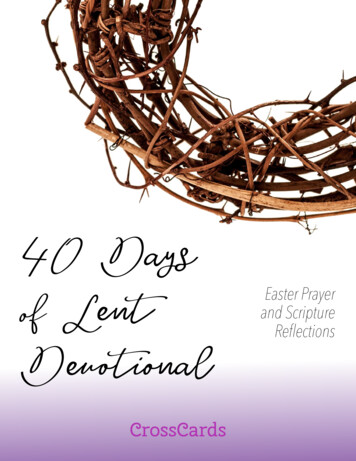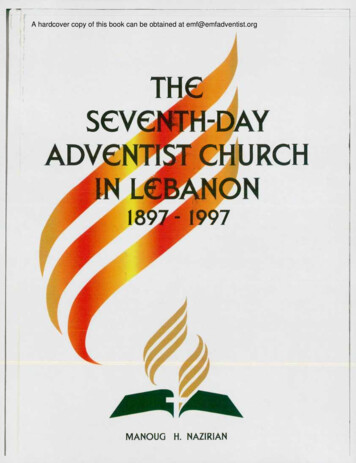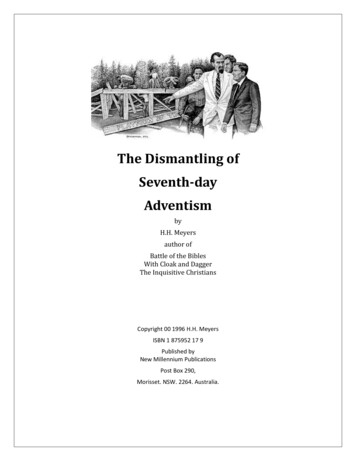
Transcription
The Dismantling ofSeventh-dayAdventismbyH.H. Meyersauthor ofBattle of the BiblesWith Cloak and DaggerThe Inquisitive ChristiansCopyright 00 1996 H.H. MeyersISBN 1 875952 17 9Published byNew Millennium PublicationsPost Box 290,Morisset. NSW. 2264. Australia.
Dismantling SDATypeset by Barlow Media Consultancy21 Amos StreetBonnells Bay NSW 2264Printed and bound by McPherson's Printing GroupContentsPagination as in original: Indicated in EBook as (#)1. The Time of The End 52. The People of the Book 93. The Westernisation of Spiritualism 124. The Fraud of Revision 165. Adventism Baited 226. The American Revised Version 277. Early Flirtation 298. Inspiration Under the Spotlight 339. Battle Lines are Drawn 3710. "A Scholar of the First Rank" 4111. Resistance to Change 4812. New Versions for a New Age 5113. The Nazi Correction 5614. Adventism's Fateful Decision 5915. Vatican II Council 6616. Adventism Adopts the MV 6917. A New Age Version 7 418. Adopting an Icon 8019. Prescott - the Man 8420. Prescott - the Reformer 8 821.666 9322. The Daily Controversy 9723. The Contextual Virus 10724. The Manipulative Virus 11025. The Prescott Syndrome In Australia 11826. A Deadly Mixture 12727. "Wither Goest Thou ? "13328. Books of a New Order 13729. The Spirit of Antichrist or the Spirit of Prophecy?30. Is Truth Progressive?151Exhibits 154-156Index 157144www.temcat.com 2
Chapter 1The Time of the End(5) It is arguably true that without the Bibles of Martin Luther and William Tyndale, both of which reliedon the New Testament of Erasmus, the world would have been denied what we have come to know asthe Protestant Reformation. These Bibles virtually gave to the Germans and the English a style of writingwhich became the forerunner of their present-day languages. In England, various language updates ofTyndale's Bible culminated with the appearance of the Authorised Bible of King James (KJV) in the year1611. With this Bible the English language reached its apogee of expression.The distinguished scholars of the KJV translation team made no secret of the fact that their Bible was abulwark against Popish traducers for in the prefacing Dedicatory to their King they saw their work as asure defence of truth, (which hath given such a blow unto the man of sin, as will not be healed)This is the Bible which inspired and gave zest to the great missionary societies which paralleled theprogress of British expansionism. But nearly 200 years were to pass before the formation of the Britishand Foreign Bible Society in 1804. This Society provided a mechanism by which the Protestant Biblecould be mass-produced and distributed widely and cheaply. The mission of the Society was clearlystated in its Constitution:The only copies in the language of the United Kingdom to be circulated by the Society should bethe Authorised Version without note or comment (Canton - "The History of the British andForeign Bible Society, 1904, Vol 1, p.17).(6) Other Protestant Bible societies such as the well-known New York Bible Society (1809) and theAmerican Bible Society (1816) soon came into existence. In 1831 the London based Trinitarian BibleSociety was formed. Although less known than the afore-mentioned societies, the Trinitarian Society stillexists, having remained true to its original resolve to distribute only the Protestant Bibles of theReceived Text and to admit as members only declared Protestants.With this unprecedented availability of affordable Scriptures and the accompanying increase in literacy,there arose a widespread interest in the Bible and the study of its prophecies. People came to realisethat the Bible was God's revealed will to man and that it could be understood and interpreted withoutthe aid of the ecclesiastical profession.The discerning reader may well wonder why it took some two centuries after the advent of theAuthorised Bible of Britain's King James I before God led men to form the great Bible societies. Theanswer is to be found in God's great prophetic time-table. He had decreed just when and where suchhistory-making events would occur. Those who were making a careful, prayerful study of the propheciesof Daniel noted the angel's instructions to Daniel, recorded in the closing chapter of his book:But thou, 0 Daniel, shut up the words and seal the book, even to the time of the end: many shallrun to and fro and knowledge shall be increased (Dan 12:4).Obviously, it was knowledge of this prophecy to which the angel specifically referred. But when was Thetime of the end?Comparatively recent events, paralleling the signs given by Christ of His second coming in Matthew24:29, were still topical subjects in North America. Protestant students had seen in the sword of theFrench Revolution, which brought about the down-fall of the Papacy, a remarkable fulfilment of (7)prophecy as outlined in Daniel 9. And, as if by common consent, Protestants have ever regarded
Dismantling SDANapoleon's capture of the pope in 1798 as the commencement of the time of the end. (See "Thoughtson Daniel and the Revelation" pp. 146, 280-281, 291, 519-521. 1944 edition).It should be noted that only six years were to elapse after this important event until the formation of thefirst Bible Society in 1804. Now, with the increased availability of the Scriptures, many more peoplewere reading and studying the prophecies. The likelihood of unlocking the mysteries of prophetic bookssuch as Daniel had been increased dramatically. It was now the time of the end.With the enormous evangelistic activities in the Protestant world, accompanied by the greatexpectations of Christ's imminent return, which characterised the early decades of the nineteenthcentury, there arose in North America what came to be known as the Millerite Movement. WilliamMiller, from his study of Daniel 8, calculated that the great 2,300 days time-prophecy would culminate in1844. He was not alone in his calculation based on verse 14:Unto two thousand and three hundred days, then shall the sanctuary be cleansed (Dan 8:14).Neither was he alone in his interpretation of the nature of the event which would bring this propheticperiod to its close. Many people had come to see the earth as the sanctuary and wishfully they allowedthemselves to see its cleansing as the second coming of Christ. But when that glorious event failed tomaterialise, the magnitude of the ensuing disappointment proved devastating to the majority of thosewho had come to be known as Adventists. A comparative few turned to God for consolation andunderstanding. Back to the Scriptures they went with much earnest prayer for guidance.Some of these disappointed ones now turned to a closer study of the books of Daniel and Revelation.Slowly they began to see Jesus Christ's revelation to John as a sequel to the prophecies given to Daniel.Clearly they came to understand the (8) great outline of climactic events which would culminate in thereturn of Christ, bringing with Him His reward to both the righteous and the wicked. There in the tenthchapter of Revelation they recognised that the seventh angel was describing the bitter experiencethrough which they had recently passed. The little book which they had swallowed was the book ofDaniel the prophet. Their understanding of the earth as the sanctuary which was to be cleansed by fire,and their expected farewell to this old world, were indeed sweet as honey. But with their terribledisappointment their belly was bitter.And he saith unto me, Thou must prophesy again before many peoples, and nations, andtongues, and kings (Rev 10:11).And prophesy they did! Ongoing study revealed that the earth could not be the sanctuary, they came tounderstand Christ's mediatorial role in the heavenly sanctuary as the antitype of the earthly sanctuaryservice which ended with the tearing of the veil in the earthly sanctuary at the time of Christ's death.The sanctuary to be cleansed in 1844 they saw as the antitypical day of atonement which thesubsequently formed Seventh-day Adventist Church has come to call the investigative judgment.11. See "Great Controversy" by E.G. White index: "Judgment-the investigative". "Daniel and Revelation" by Uriah Smith pp. 162187 & 628-676www.temcat.com 4
Dismantling SDAChapter 2The People of the Book(9) We do well to remember that the Bible used by the early Adventists both before and after 1844 wasthe Authorised Version of King James. This Bible and other language Bibles which were translated from itwere the only ones promoted by the early Bible Societies. In recognition of the vital role played by theseBibles in the spread and maintenance of Protestantism it is instructive to hear what Faber, one of theRomanising clergymen of the Church of England, had to say in his new role as a prelate of the RomanChurch in England.Who will say that the uncommon beauty and the marvellous English of the Protestant Bible is notone of the great strongholds of heresy in this country (Edie, "The English Bible", Vol 2, p.38)The heresy of course was the heresy of Protestantism as taught by the early Church of England and thenumerous Protestant sects, many of which thrived on the Bread of Life and blossomed into respectedProtestant denominations. This was particularly so of the Sabbath-keeping Adventists who, in the year1860, officially adopted the name Seventh-day Adventists - a generic name denoting two of theiroutstanding beliefs.Having acknowledged the Protestant Bible as the source and guide of Protestantism, it was only logicalthat Rome should seek to deprive the heretics of their great stronghold of heresy, the King James Bible.Especially was this imperative in the case of the expanding Seventh-day Adventist Church.(10) Here was a denomination which had discovered from the Protestant Bible the real purpose of theJewish sanctuary service in pointing Israel to the antitypical role of Jesus Christ, our great High Priest andMediator, in the heavenly sanctuary. They had heeded the message of the first angel of Revelation 14 toprepare the world for the great time of the "investigative judgment which commenced in 1844. To trulyworship the Creator they should rest with Him on the day which He had set aside as a memorial of Hiscreative power. In accordance with the messages of the second and third angels of Revelation 14, theywere calling people to come out of the great counterfeit of Christianity which is identified by God as thatgreat city of Rome, also known as fallen Babylon, whose chief representative, the pope, is identified bythe number of the beast of Revelation 13 - Six hundred three score and six.They had discovered that their movement had arisen on time as foretold in prophesy and they identifiedthemselves with the Remnant Church that [keeps] the commandments of God and has the testimony ofJesus Christ (Rev 12:17). Accordingly, they saw themselves as the instrument of the three angels and setabout taking the everlasting gospel to every nation, and kindred, and tongue and people (Rev 14:6).Truly Rome was now confronted with a real Protestant church - a church which refused Rome'sauthority to change times and laws (Dan 7:25); a church which confronted her priests with Jesus Christas the one and only mediator between God and man (1 Tim 2:5); a church which saw a great high priestwhose work was not on earth but in the holiest place, within the veil (Heb 6:19; 9:3) of that more perfecttabernacle in heaven (Heb 9:11); a church which was calling people to come out of Babylon lest they befound wanting in the judgment and drink of the wine of the wrath of God which is poured out withoutmixture (Rev 14:10); and a church which believed that blessed are they that do [all] his commandments(Rev 22:14).Such a church could not be tolerated by Rome. The People of the Book must by some means, or other,be deprived of their rule of faith.(11) In a Protestant-dominated society compulsive force, such as inquisitorial methods of punishment iswww.temcat.com 5
Dismantling SDAno longer an option. Attempts to replace Protestant Bibles with Catholic ones, such as when the Englishwere presented with the Douay Bible in the late sixteenth century, had failed. But would it now be at allpossible to co-opt Protestants themselves in an attempt to have them destroy their own Bible? In thepast, many a Church of England cleric had been induced to turn traitor. Why not now?And what about the real Protestants who insisted on living out the Bible injunction to call people out ofthat counterfeit system of Christianity identified as Babylon? Would it be possible to trick the Seventhday Adventist Church into forsaking their Protestant Bible? Or perhaps they would accept a Bible that toall intents and purposes was Protestant, yet one that translated key texts in such a way as to underminekey doctrinal beliefs! And what if The People of the Book could be conned into taking a leading role inpromoting spurious versions among professing Protestant churches? Would they not be inclined to takenotice of The People of the Book?Rome is very patient. Her plans formulated at the Council of Trent (1545-1563) in the mid-sixteenthcentury are still being methodically put into effect.2In order to answer such questions we shall first delve a little into the history of Satan's plans tocontradict God's Word, and look at some of the machinations of his chief agents in presenting theProtestant world with his clever counterfeit Scriptures - a counterfeit with which he hopefully woulddeceive the very elect.2In later chapters we shall see how the Seventh-day Adventist Church has related to these plans.www.temcat.com 6
Dismantling SDAChapter 3The Westernisation of Spiritualism(12) We have noted that in the time of the end there arose tremendous interest in the study of God'sWord which had been expedited by the timely emergence of Protestant Bible societies; yet it would bevery naive to expect Satan to sit back passively, doing nothing to hinder the spread of the "everlastingGospel" with its judgment hour message. On the contrary, the prince of this world, Lucifer, who hadbeen cast out of Heaven (Isaiah 14:12) and who had obtained the mastery over our first parents, couldand would be expected to do all in his power to retain that mastery.It will be recalled that in yielding obedience to the serpent (Lucifer), Eve had been subjected to itsplausible reasoning which was in contradiction to God's express commandments. First came theinsinuation of doubt as to the validity and authority of God's word. Yea hath God said. Then came thecontradiction, Ye shall not surely die. Quickly Satan followed up with enticing benefits to be gained fromdisobeying God's command: For God doth know that in the day ye eat thereof, then your eyes shall beopened and ye shall be as gods, knowing good from evil (Gen 3:2-5).In essence, Satan was here laying down the principles of spiritualism:1. That Satan's word is authoritative.2. That the soul is immortal.3. That the imbibing of his knowledge would enable his servants to attain the status of deity.4. That by implication Lucifer is the light bearer and saviour of the world, for had he not said: Iwill be like the Most High (Isaiah 14:14).So, at the time of the end, why not re-employ this deception among those who are presenting God'send-time message to a judgement-bound world?Already Satan had in place that great pseudo-Christian power known as Roman Catholicism. In the earlyChristian era it had imbibed mystical beliefs of the Babylonian era which were passed on to it by theGrecian Gnostics, Egyptian necromancers and many of the superstitious rites of the pagan world intowhich Christianity was spreading.Now, with the ascendancy of Protestantism and the consequent diminished power of the papacy, whynot use the medium of spiritualism as a means to bridge the gulf between Catholicism andProtestantism? To achieve this end, a return to the counterfeit Christianity with which Constantine theGreat had clothed Christianity would go a long way to restoring the lost political clout which the RomanChurch enjoyed before the Reformation.Hard on the heels of the great disappointment of 1844, Satan took advantage of the prevailingemotional and spiritual vacuum, and introduced modern spiritualism to the Christian world. Beginning in1848 with the Fox family of New York State, USA, communication in the form of rappings wasestablished with an unseen power. The "science" of occultism grew rapidly and soon mediums sprangup throughout the Western world who claimed to have intelligent contact with the dead.Experimentation with modern-day necromancy was not confined to those outside the pale of professingChristians. In England, two Cambridge clerics who have since left an indelible influence on Biblicaltextual criticism allowed their curiosity for the occult to get the better of them. They were Drs BrookeFoss Westcott and Fenton John Anthony Hort, both of whom ignored the command of God:www.temcat.com 7
Dismantling SDAThere shalt not be found among you . a charmer or a consulter with familiar spirits, or a wizard,or a necromancer (Deut 18:10, 11).Neither did they conform to the laws of the Church of England when in 1851 they became the chiefinstigators and founding members of the Ghostly Guild of London. Almost at the same time, Westcotthypocritically consented to ordination as a priest in the Church of England. In that same year, Hortindulged his passion for the Greco-pagan philosophy of Plato and Aristotle by forming the PhilosophicalSociety. He soon was to follow his friend into the priesthood after diligent preparation for his ordination.If such inconsistencies presented no problems for these adventurers, the same cannot be said for theiremploying church and Protestantism generally. They would not only rationalise the Protestant Bible byprinciples agreeable to their philosophical outlook, but would soon lay plans to replace that Bible withtheir own revision of the Greek New Testament. (Westcott, Vol 1, pp 229, 240).No doubt, such conduct by the Cambridge doctors was indicative of Satan's crafty plans to hitch a rideon the back of Christianity. But out in the Eastern world of paganism, full blown spiritualism had longbeen entrenched. In countries such as India and Tibet there already existed sophisticated religions ofdivine illumination through imparted knowledge, which contrasts with the Scriptural method of a divinerevelation as espoused by Christianity.A young Russian divorcee by the name of Helen P. Blavatsky, while still in her late teens, embarked on aremarkable quest to learn the secrets of the Oriental masters of occultism. She spent prolonged periodswith the Mahatmas of India and Tibet, learning their secrets and reinforcing her disdain for her nativeChristianity. During this period, in the year 1851, she made her first visit to England. This traditionalstronghold of Protestantism was fast gaining a reputation as a focal point for the melding of Westernand Oriental occultism.While in London, Madame Blavatsky had a chance meeting with an Indian mystic. She became soenchanted with him that he was spontaneously adopted as her lifelong guru.Over the next four decades, Blavatsky actively continued her investigative career, learning more of thesecrets of the Mahatmas, frequently re-visiting England and travelling widely on lecture tours. In 1875,she was responsible along with an American, Col H S Olcott, for founding the Theosophical Society withheadquarters in the United States of America. This anti-Christian society and its occult Luciferianphilosophy had great influence over the ministry of the modernists in Protestantism, and a remarkablysignificant impact on the corrupting of the Protestant Bible.In order to pursue this subtle transformation from the plain Word of God to Satan's contradiction of theWord, as in the New Age Versions, we should look at the Romanising influence on Anglicanism and, inparticular, on Doctors Westcott and Hort who were largely responsible for insinuating into their churcha Roman Catholic corrupted New Testament.www.temcat.com 8
Chapter 4The Fraud of Revision(16) Following his open defection to Roman Catholicism, Cardinal John H Newman,3 formerly a cleric ofthe Church of England and founder of the Oxford Movement in 1833, was invited to re-visit the Vatican.While there, he disclosed some details of his mission in a letter dated January 17, 1847 to his fellowtraitor, Nicholas P Wiseman. Referring to a request made by a senior member of the Congregation ofthe Index4 he wrote:. that we should take the Protestant translation, correct it by the Vulgate . and get itsanctioned here. This might be our first work if your Lordship approved of it. If we undertook it, Ishould try to get a number of persons at work (not merely of our own party). First, it should beoverseen and corrected by ourselves, then it should go to a few select Revisers, e.g. Dr Tait ofUshaw, Dr Whiny of St Edmunds [a Jesuit] (Ward, "Life of Wiseman" Vol 1, p 454).Here we see cogent evidence of Rome's continuing efforts to implement plans for the destruction ofProtestantism, as worked out at the Council of Trent, by depriving Protestants of their Bible. Their latesixteenth-century attempt in the form of the Rheims/Douay Bible had been a failure. This time Romewould3See "Battle of the Bibles", Chapter 17.4The Index is a list of writings prohibited by the papacy.(17) use subterfuge by agitating for a translation that was authorised by the Church of England. Asprofessing Protestants would be seen to be in charge of the translation, the whole thing would be seento be a Protestant affair! Yet all the while, it should be overseen and corrected by Roman Catholics. Inother words - a plan for Protestants to assist in the destruction of the very basis of their being!Newman and Wiseman didn't have to look far to find Englishmen to do just that. Oxford and Cambridgewere fast succumbing to the modern liberalism of the Counter-Reformation in Germany and France andthe infiltrating tactics of the Rheims Jesuits.But there were two Cambridge professors in particular who were flaunting their liberalism publicly - theafore-mentioned Drs Westcott and Hort whom we have seen to be founding members of the GhostlyGuild. Prior to such reckless pursuits, they had revealed their preferences for the mystical rituals ofRome rather than the verities of God's Word. Even while the Congregation of the Index was plotting thedestruction of the King James Bible, Westcott, after visiting a little oratory near a monastery in France,wrote his fiancee:Behind a screen was a 'Pieta", the size of life. [The Virgin Mary nursing the dead Christ in her lap]I could have knelt there for hours ("Life of Westcott" Vol 1, p 81).Some eighteen years later, he wrote Archbishop Benson:I wish I could see to what forgotten truth Mariolitary bears witness (ibid p 251).His friend Hort revealed a deplorable lack of appreciation for the Gospel when he wrote to Westcott in1865 saying:I have been persuaded for many years that Mary worship and "Jesus" worship have very much incommon in their causes and results ("Life of Hort" Vol 2, p 50).
Dismantling SDA(18) It would be very surprising if these men were not attracted to Newman's Oxford Movement and itsTractarianism. At least we have proof that Westcott was one of Newman's admirers. In 1864 he wrotehis fiancee:Today I have again taken up Tracts for the Times and Dr Newman. Don't tell me that he will dome harm. At least today he will, has, done me good, and had you been here I should have askedyou to read his solemn words to me ("Life of Westcott", Vol 1, p 223).Well may we imagine the nature of the solemn words. Remember Newman's commission from Rome in1847, to enlist Protestants in the work of correcting their Bible by the Roman Catholic Vulgate? Whatbetter candidate for the job than Westcott, who along with his friend Hort, were prepared to stay withinthe English Protestant system while "biting the hand that fed them". Besides, for the previous eightyears they had found time, in spite of extra curricular activities such as attending the Ghostly Guild, tobury themselves in the translation of a Greek New Testament. This would be of great interest toNewman, especially if, as most likely, he would be aware that the professors who despised the KingJames Version, and consequently Protestantism, were using the recently discovered SinaiticusManuscript (believed to be one of Constantine's Alexandrian Bibles along with the Vaticanus) as a basisfor their translation. If the resulting Greek New Testament was to be used to correct the English NewTestament then Protestants would indeed receive a Bible corrected by the Vulgate.During the two decades that Westcott and Hort were employed on their Greek New Testament, thecorroding influence of the Oxford Movement on the Church of England was building up a theologicalbias among men of authority in favour of Rome, her spiritualism and her liturgy. As many of the tenetsand institutions of Protestantism came under attack, so too did the Protestant Bible. The Received Texton which the KJV was based was ridiculed as a text which was inferior to the Roman Catholic Vulgate. Inhis "Tract 90", Newman portrayed (19) the KJV as a spurious text and proclaimed the Catholic Vulgate atrue comment on the original text. It was such seeds of anti-Protestant Bible sentiments that were nowbearing fruit in the Church of England. Demands for a revision of the KJV became the order of the daybut when the proposition was put to the Church at large it met with little enthusiasm. The NorthernConvocation sensed danger saying:The time was not favourable for revision, and that the risk was greater than the probable gain(W F Moulton, "The English Bible", p 215).However, the Southern Convocation finally approved of revision subject to strict provisions. Limitationsapplying to the New Testament indicated their concerns:That revision should touch the Greek Text only where found necessary; should alter the language onlywhere, in the judgment of most competent scholars, such change was necessary; and in such necessarychanges, the style of the King James should be followed (Wilkinson, "Our Authorised Bible Vindicated", p164).When the committee for revision of the New Testament was announced, both Westcott and Hort werenamed. At the time, no one had any inkling that these two men had produced a Greek New Testamentof their own, and that they would succeed in secretly foisting it upon the majority of the committee. Notuntil a few days prior to the publication of the Revised Version in 1881 was their Greek New Testamentreleased to the public.Yet, a few weeks earlier, when it was evident that the revision would soon be an accomplished fact,Cardinal Wiseman could scarcely contain his exuberance. He exclaimed:www.temcat.com 10
Dismantling SDAWe cannot but rejoice at the silent triumph which truth has at length gained over clamorouserror. For, in fact, the principle writers who have avenged the Vulgate, and obtained for it itscritical pre-eminence are Protestants (Wiseman, "Essays", Vol 1, p 104).(20) Here is indisputable evidence that, although the revisers worked in great secrecy, Wiseman, thePrimate of the Catholic Church in England, was privy to the subterfuge. He and Newman had carried outthe instructions given to them by the Vatican to the letter. Instead of a revision of the KJV the EnglishProtestants had been presented with a Bible that had been "corrected" by the Vulgate.(In spite of this first-hand evidence, within Adventism today, we find official church publications such asthe South Pacific Division "Record" [July 22, 1995] trumpeting the claim of revisionists that Rome had noinput into the modern versions).'But was that all? Had Satan succeeded in further contradicting and promoting doubt in God's Word?Had he further promoted the immortality of the soul? Had he advanced his claim to be the true light ofthe world by distancing himself from Lucifer, the fallen one? He certainly had, and out of the hundredsof significant changes from the KJV we shall mention three corruptions of Scripture not even found inthe Catholic Douay Version.1. 2 Tim 3:16All Scripture is given by inspiration of God (KJV)Every Scripture inspired by God is also profitable 6 (RV)The Dublin (Catholic) Review, July 1881 gloatingly commented on the change:It (Protestantism] has also been robbed of its only proof of Bible Inspiration2. 2 Peter 2:9to reserve the unjust unto the day of judgment to be punished (KJV)to keep the unrighteous under punishment unto the day of judgment (RV)5 Article by Avondale Theological Head Dr Thompson.6 (Note the word "also" - In addition to Roman Tradition?)(21) Not only does this rendition teach the immortality of the soul but it introduces the Roman dogma ofpurgatory.3. Isaiah 14:12How art thou fallen from heaven, 0 Lucifer, son of the morning (KJV)How art thou fallen from heaven 0 day star (RV)Lucifer's name isn't even mentioned. Therefore this rendering fails to identify him as Satan - the onewho was cast out of heaven.Madame Blavatsky, the Luciferian, was ecstatic. In her book "Isis Unveiled" she gleefully comments:That which for nearly 1500 years was imposed on Christendom as a book, of which every wordwas written under the direct supervision of the Holy Ghost; . is now being translated, revisedand corrected (Vol 2, pp 125, 252).Madame Blavatsky had other reasons to be happy with the Revised Version. Therein she foundScriptural support for her Aryan beliefs of racial superiority which she learned from the Brahmanteachers of the caste system of India; e.g. Luke 2:14 and Acts 17:26. We shall deal with this aberration ina later chapter.www.temcat.com 11
Dismantling SDAChapter 5Adventism Baited(22) Now that we have revealed some of the schemes by which Rome successfully applied "corrections"to the Protestant Bible, we shall return our attention to Satan's continued eff
Tyndale's Bible culminated with the appearance of the Authorised Bible of King James (KJV) in the year 1611. With this Bible the English language reached its apogee of expression. The distinguished scholars of the KJV translation team made no secret of the fact that their Bible


![Welcome [dashdiet.me]](/img/17/30-day-weight-loss-journal.jpg)
